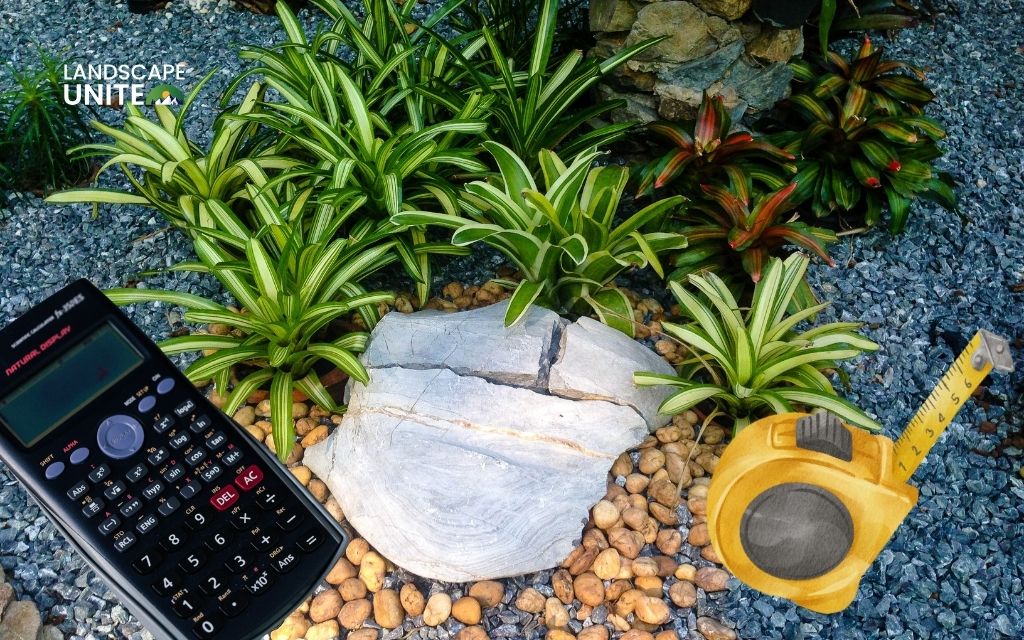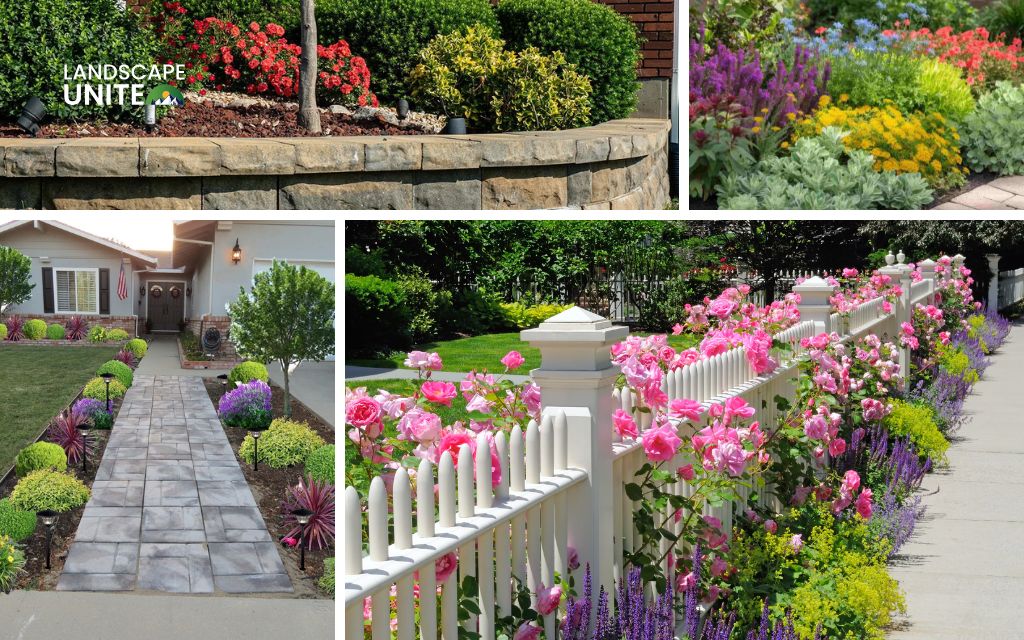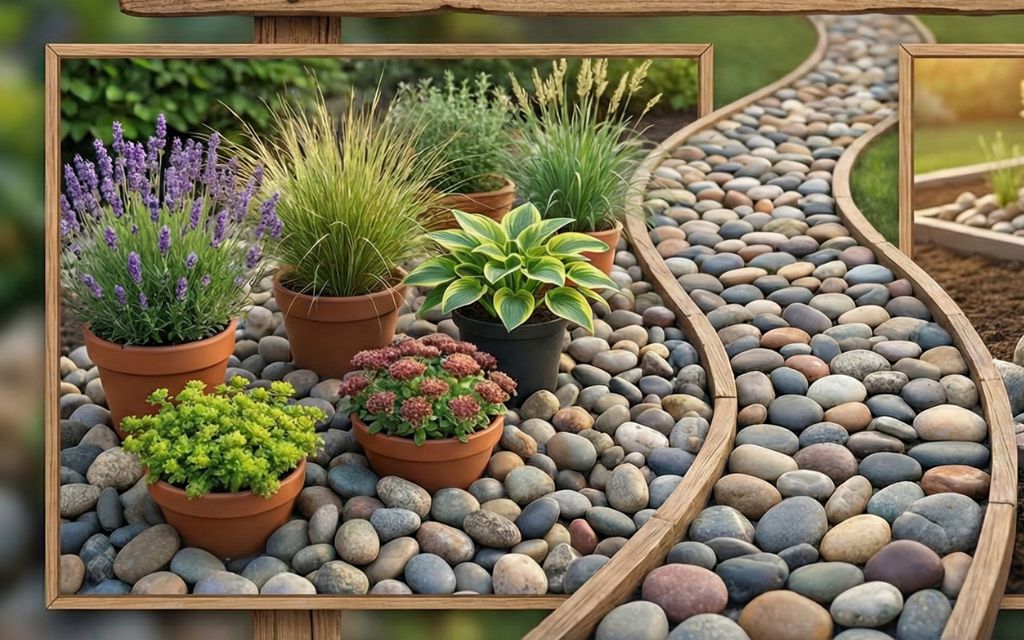Small flower beds offer unique advantages over larger gardens. They’re budget-friendly, manageable for busy homeowners, and perfect for experimenting with new plant combinations.
In this comprehensive guide, you’ll discover 28 inspiring images of small flower bed ideas with detailed design principles, and plant recommendations. From cottage-style charm to modern minimalism, these images will help you transform any small space into a garden showpiece.
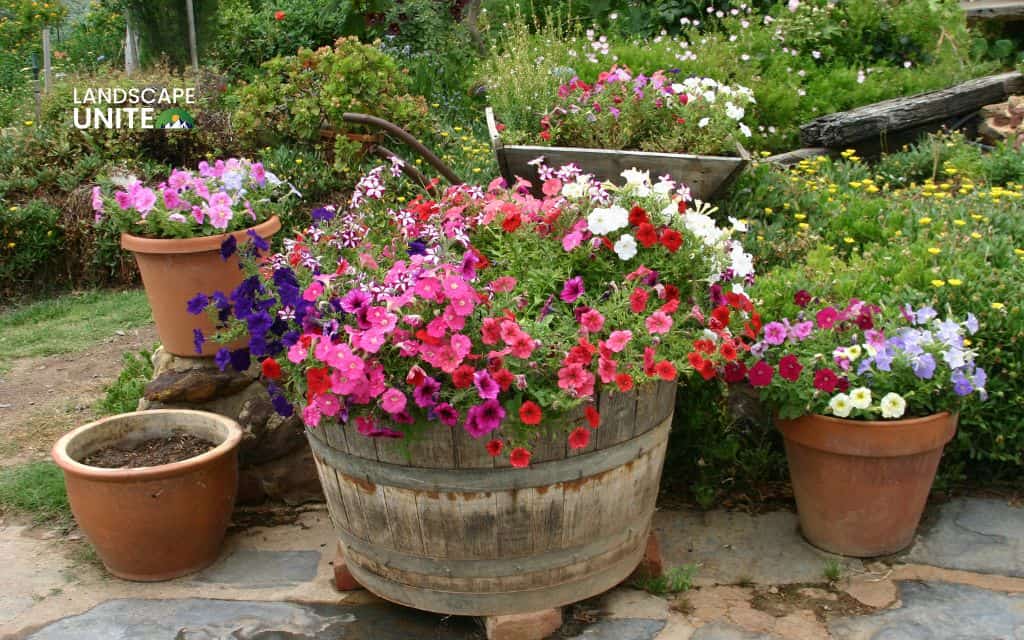
How to design a small flower bed that feels big
Plan with purpose
Before breaking ground, clarify your objectives. Are you seeking to boost curb appeal for resale value? Create a private retreat for personal enjoyment? Attract pollinators to support local ecosystems? Your goals will guide every design decision from plant selection to layout.
Start by studying your space throughout the day:
- Note which areas receive morning sun, afternoon shade, or full exposure.
- Check how water drains after rain – does it pool or run off quickly?
- Test your soil by digging a small hole; clay soil holds moisture while sandy soil drains rapidly.
These observations will determine which plants will thrive in your specific conditions.
Use height and layers to create depth
The secret to making small spaces feel substantial lies in vertical layering.
- Position your tallest plants at the back of border beds or in the center of island beds.
- Fill the middle layer with medium-height plants, and edge with low-growing species that spill gracefully over borders.
This three-tier approach creates visual depth that tricks the eye into perceiving more space.
For example, pair tall purple salvia (24 inches) with mid-height coral bells (12 inches) and low creeping thyme (3 inches). The varied heights create a natural, layered look that feels established and intentional.
Stick to a cohesive color palette
Professional designers rely on the 60 – 30 – 10 color rule for balanced results. Choose one dominant color for 60% of your plants, a complementary secondary color for 30%, and a bold accent color for the remaining 10%.
Consider your home’s exterior when selecting colors. Warm-toned flowers like orange marigolds and yellow coreopsis complement brick and earth-tone siding. Cool colors such as purple salvia, white alyssum, and silvery lamb’s ear enhance gray, blue, or stone exteriors.
Remember that green foliage counts as a color too. Use plants with variegated or colored leaves to add interest even when flowers aren’t in bloom.
Choose scaled-down plants
Proportion matters in small spaces. Oversized plants can overwhelm tiny beds, making them feel cramped and unbalanced.
Look for descriptors like “dwarf,” “compact,” “mini,” or “petite” when shopping.
- Dwarf hydrangeas reach only 3 – 4 feet instead of 8 feet.
- Compact salvias stay under 18 inches rather than sprawling to 3 feet.
These smaller varieties provide the same visual impact without dominating your space.
Perennials like dianthus, catmint, and coreopsis naturally stay compact while providing season-long color. Annual options include petunias, lobelia, and dwarf zinnias that bloom from spring until frost.
Simplify maintenance
Small flower beds should enhance your life, not become a burden.
Focus on perennials that return each year, reducing replanting costs and effort. Native plants typically require less water, fertilizer, and pest control since they’re adapted to local conditions.
Apply 2 – 3 inches of organic mulch around plants to suppress weeds, retain moisture, and create a polished appearance. Consider installing drip irrigation or soaker hoses for efficient, automated watering that saves time and conserves water.
28 images of small flower bed ideas for inspiration
(All photos are for illustrative purposes only.)
1. Front walkway border bed
Transform your entrance with a welcoming border of low-growing, colorful plants. Plant compact petunias in shades of pink and white, interspersed with sweet alyssum for continuous fragrance. Add structure with small, rounded boxwood shrubs spaced every 4 – 5 feet.
This design works because it creates maximum visual impact at eye level and remains low enough not to obstruct views. The repeated elements provide unity, while the mixed textures add interest along the entire walkway.
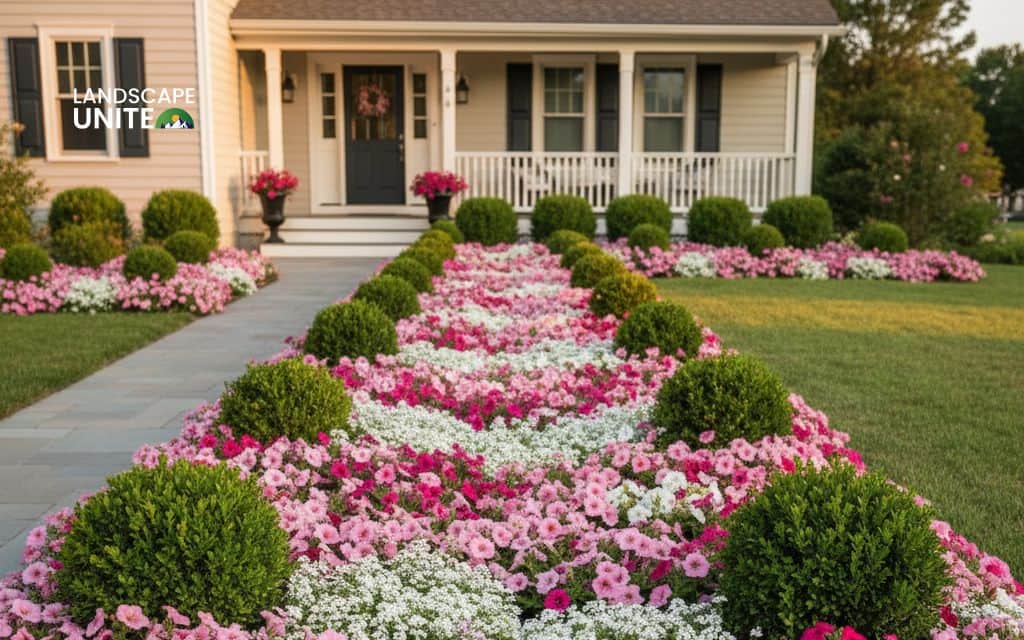
2. Corner flower bed for small yards
Unused corners offer perfect opportunities for triangular beds that maximize planting space while fitting naturally into landscape angles.
Anchor the back corner with ornamental grass like fountain grass or feather reed grass. Fill the middle area with purple coneflowers for summer color and winter seed heads that attract birds.
Edge the front with creeping thyme, which releases fragrance when stepped on and produces tiny purple flowers. Add a decorative boulder or small birdbath as a focal point to give the eye a place to rest.
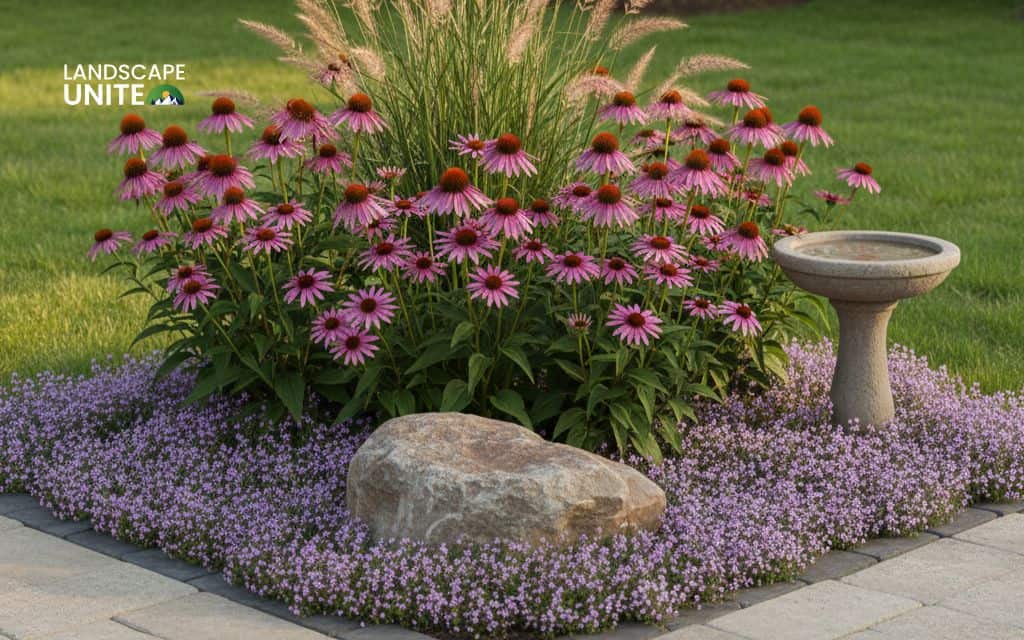
3. Raised stone flower bed
Elevation adds drama and definition to flat yards while providing better drainage for plants that prefer drier conditions. Build retaining walls 18 – 24 inches high using natural stone, concrete blocks, or brick. Fill with well-draining soil mix.
Plant the upper level with sun-loving begonias in vibrant reds and pinks. Add lavender for its silvery foliage, purple flowers, and delightful fragrance. The height difference creates a natural amphitheater effect that showcases each plant.
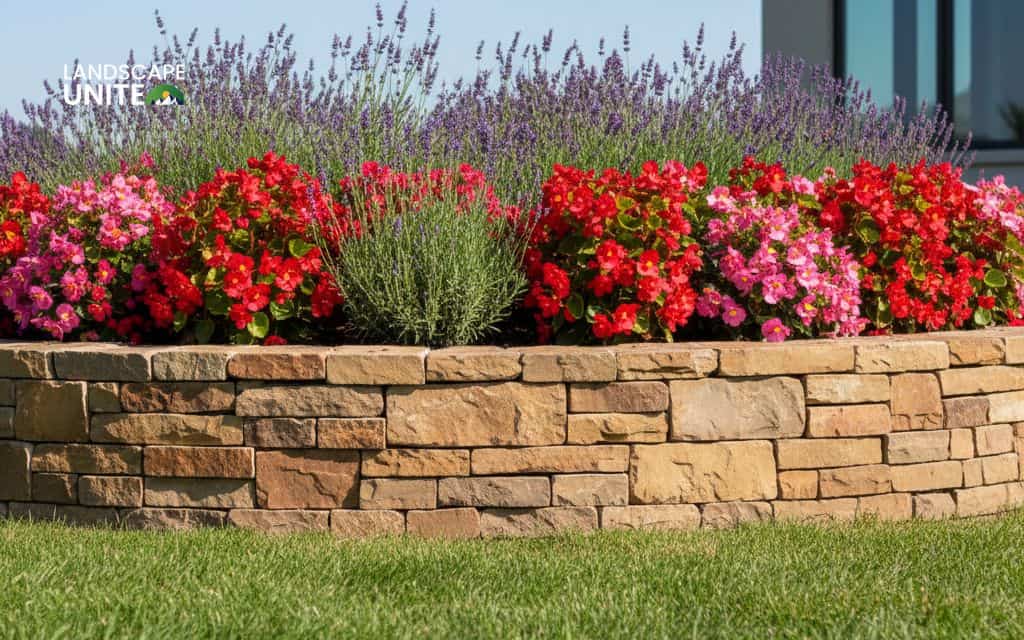
4. Circular centerpiece bed
A circular bed in your front lawn creates an elegant focal point visible from multiple angles.
Start with a central plant like a dwarf ornamental tree or large shrub. Surround it with mid-height perennials such as daylilies and Shasta daisies in repeating patterns.
Edge the circle with low-growing annuals for seasonal color changes. Install solar-powered LED lights among the plants for stunning nighttime curb appeal.
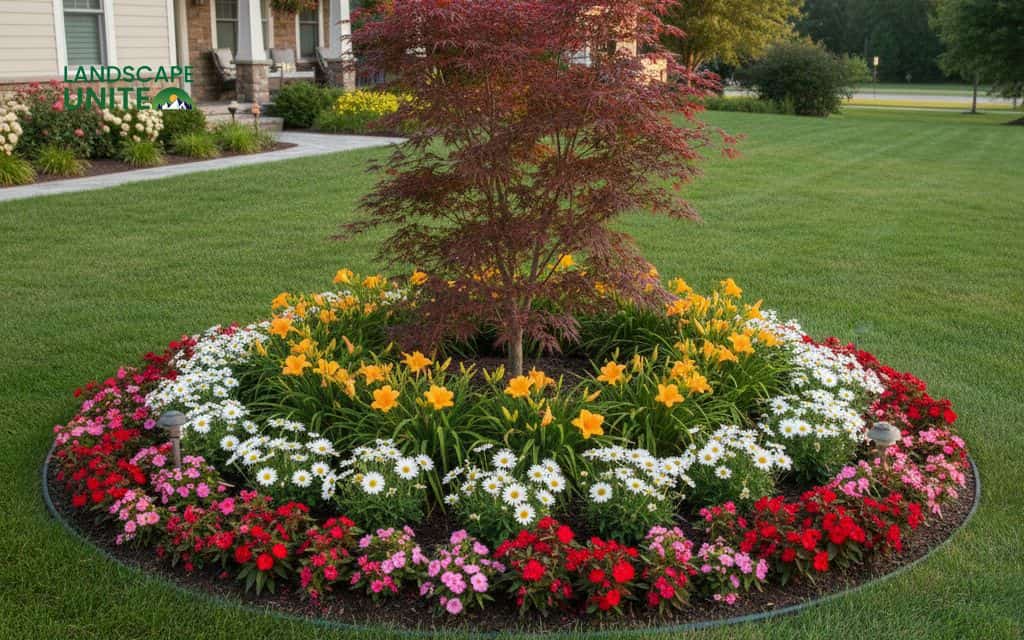
5. Side-of-house flower strip
Transform the neglected strip between your house and property line into a lush shade garden. This often-overlooked space typically receives filtered light perfect for hostas with their architectural leaves in shades of green, blue, and gold.
Complement hostas with feathery astilbe in pink, white, or red for spring color. Add native ferns for fine texture and year-round interest. This combination creates a cool, peaceful retreat that requires minimal maintenance once established.
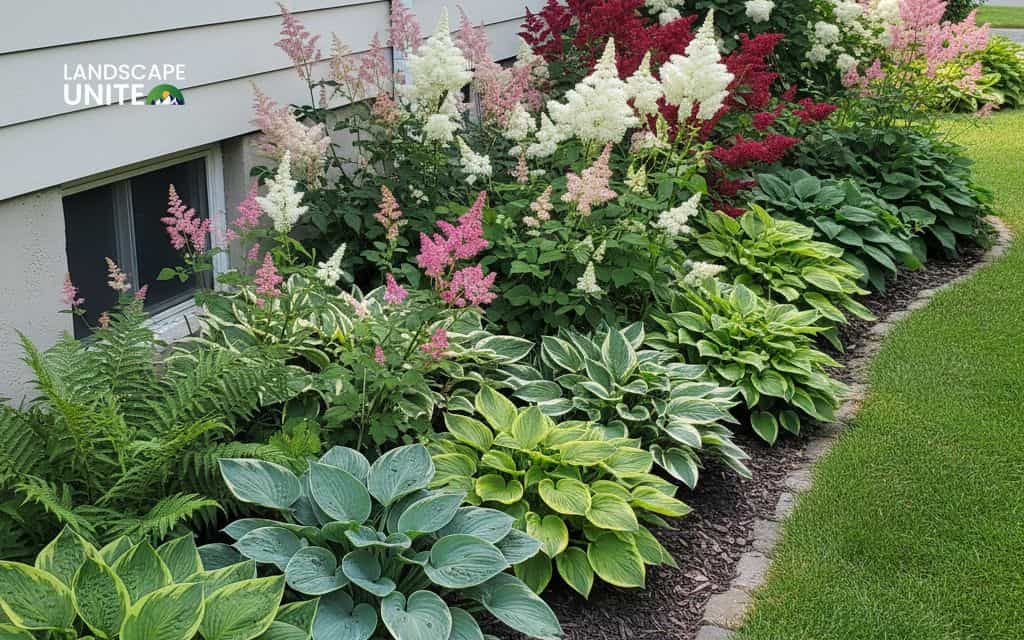
6. Container cluster flower bed
Perfect for renters or anyone wanting flexibility, container gardens allow complete design control and easy seasonal changes. Group pots of varying heights and sizes, using matching materials for cohesion – all terracotta, galvanized metal, or glazed ceramic.
Fill larger containers with upright plants like geraniums or coleus. Use medium pots for mounding plants like petunias. Small containers work well for trailing varieties like ivy or calibrachoa that spill over edges.
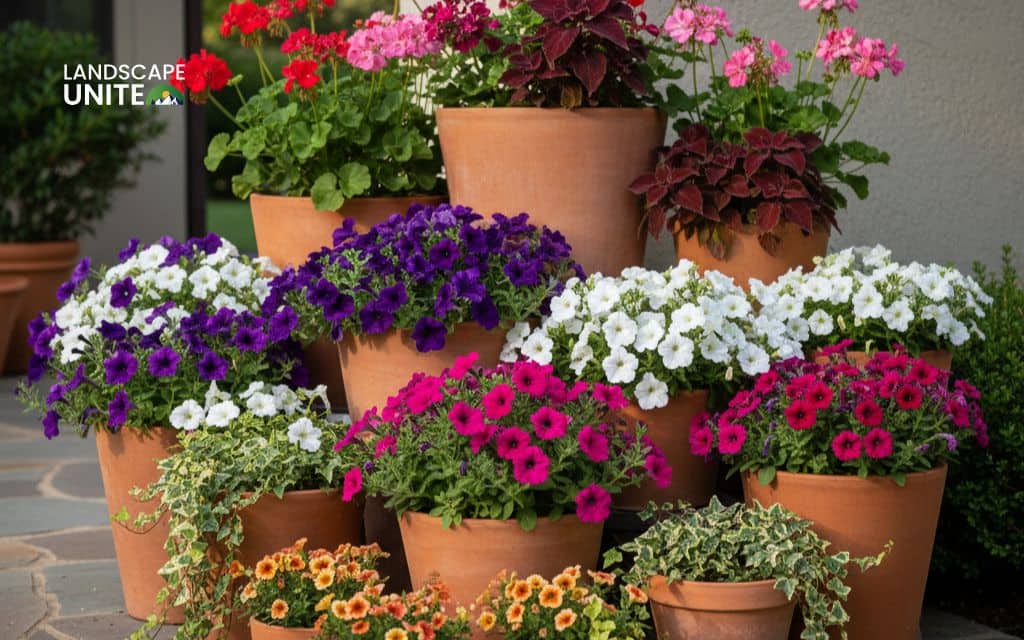
7. Rock-and-bloom combo bed
Combine the low-maintenance appeal of rock gardens with seasonal flower color. Create a base of decorative gravel or river rock, then plant drought-tolerant succulents like hens and chicks, sedums, and small agaves. Add pops of color with hardy perennials like blanket flower, black-eyed Susan, or purple coneflower.
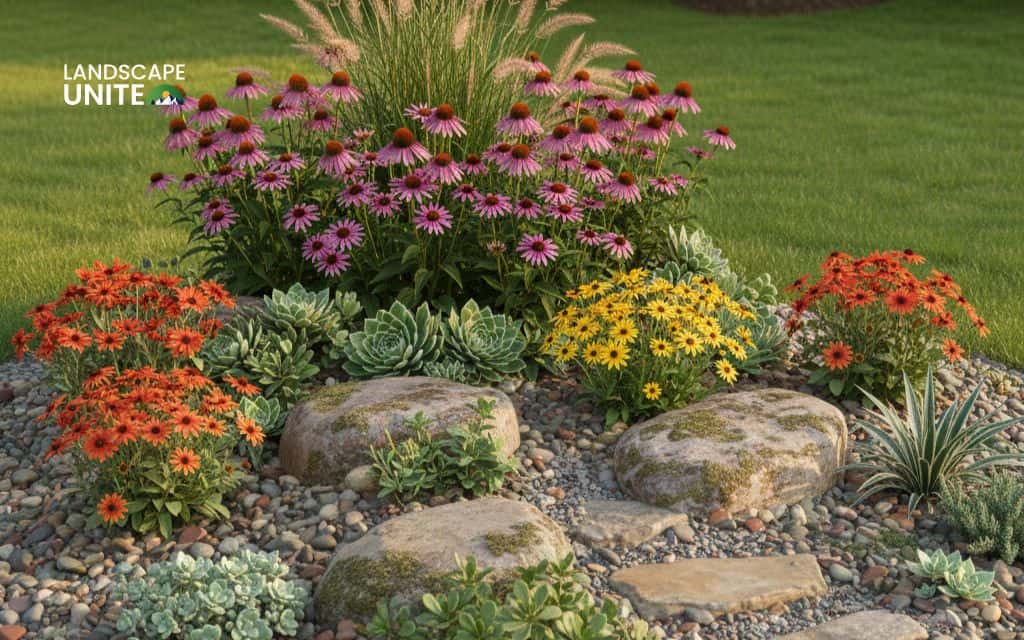
8. Small shade garden bed
Shady areas need not be boring. Create a tropical-feeling oasis with bold foliage plants that provide color without flowers. Caladiums offer heart-shaped leaves in pink, red, and white patterns. Impatiens provide continuous blooms in shade conditions. Use dark mulch to make bright colors pop and create strong contrast that enhances the overall design.
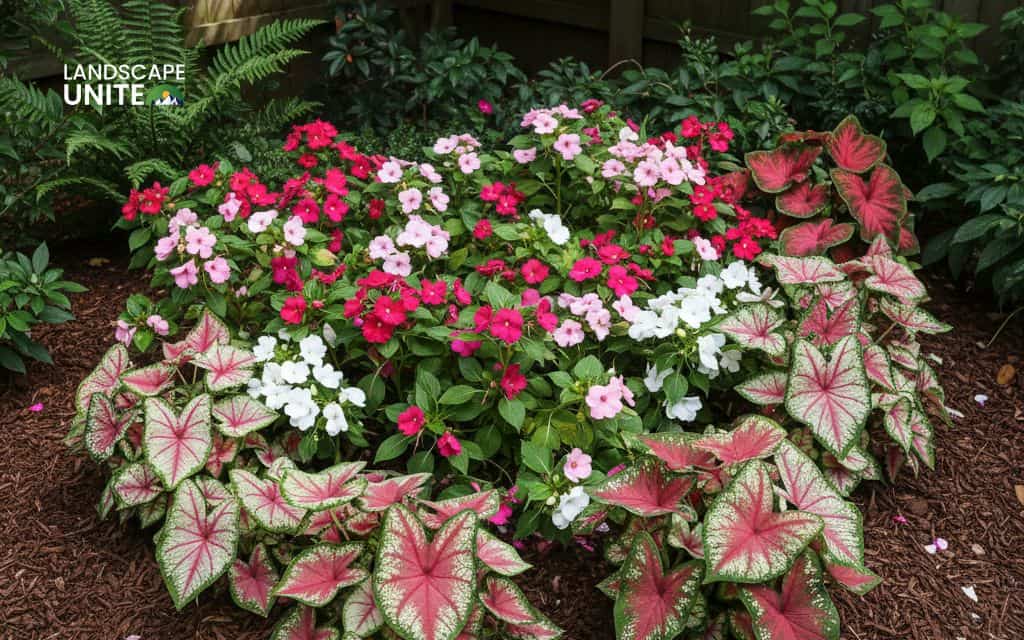
9. Curbside flower bed with native plants
Design a pollinator paradise that requires minimal maintenance and supports local ecosystems.
- Black-eyed Susans bloom from midsummer through fall, providing nectar for butterflies and seeds for birds.
- Purple coneflowers attract goldfinches to their seed heads.
- Ornamental grasses like little bluestem provide texture, movement, and winter interest.
These native combinations establish quickly and tolerate drought once mature.
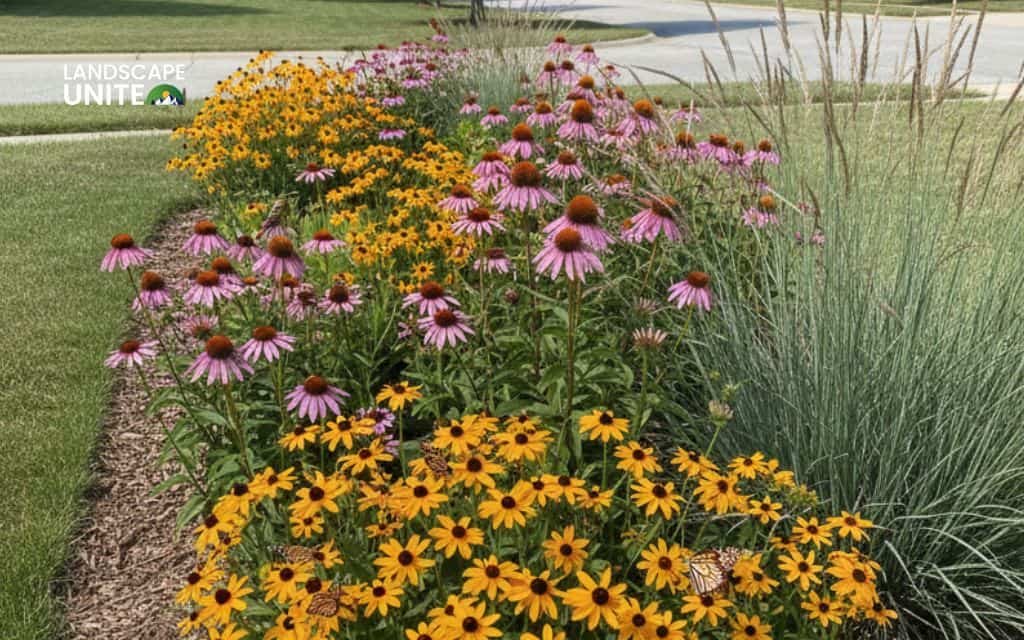
10. Layered front porch bed
Frame your front porch with a classic design that provides year-round structure.
- Plant dwarf holly or boxwood in the back for evergreen structure.
- The middle layer features bright marigolds or seasonal annuals for changeable color.
- Front edges showcase trailing plants like vinca or sweet potato vine.
Choose plants that complement your home’s architectural style – formal plants for traditional homes, relaxed combinations for cottage styles.
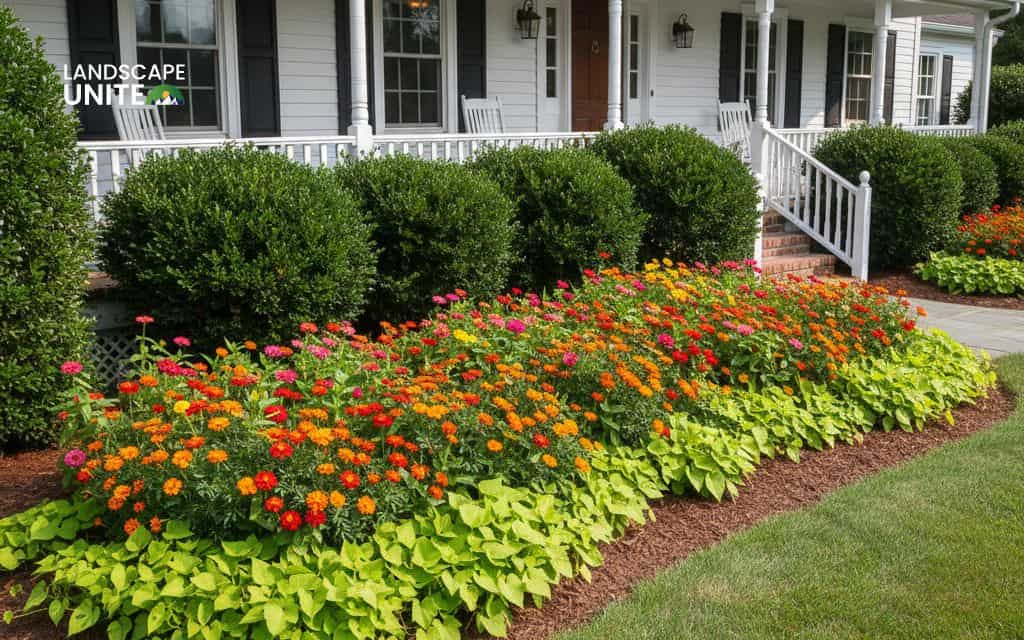
11. Budget-friendly DIY bed
Create maximum impact with minimal investment by combining annuals with perennials. Start seeds of zinnias and cosmos indoors for abundant summer color at a fraction of nursery plant costs.
Invest in perennial foundations like coreopsis and sedum that return each year. These hardy plants multiply over time, providing divisions for expanding your garden or sharing with friends.
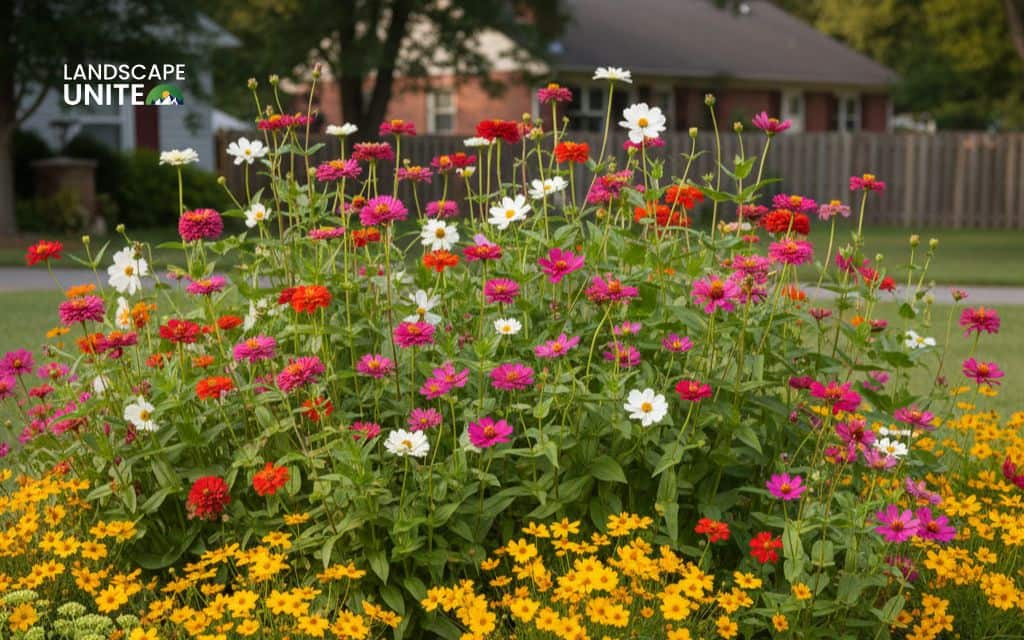
12. Raised wooden planter bed
Ideal for patios, decks, or areas with poor soil, raised wooden planters provide perfect growing conditions while adding architectural interest. Build boxes 18 – 24 inches high using cedar or composite materials for longevity.
Combine flowering plants with herbs for beauty and function. Geraniums provide continuous color while rosemary and basil offer culinary benefits. The elevation makes maintenance easier and creates better visibility for shorter plants.
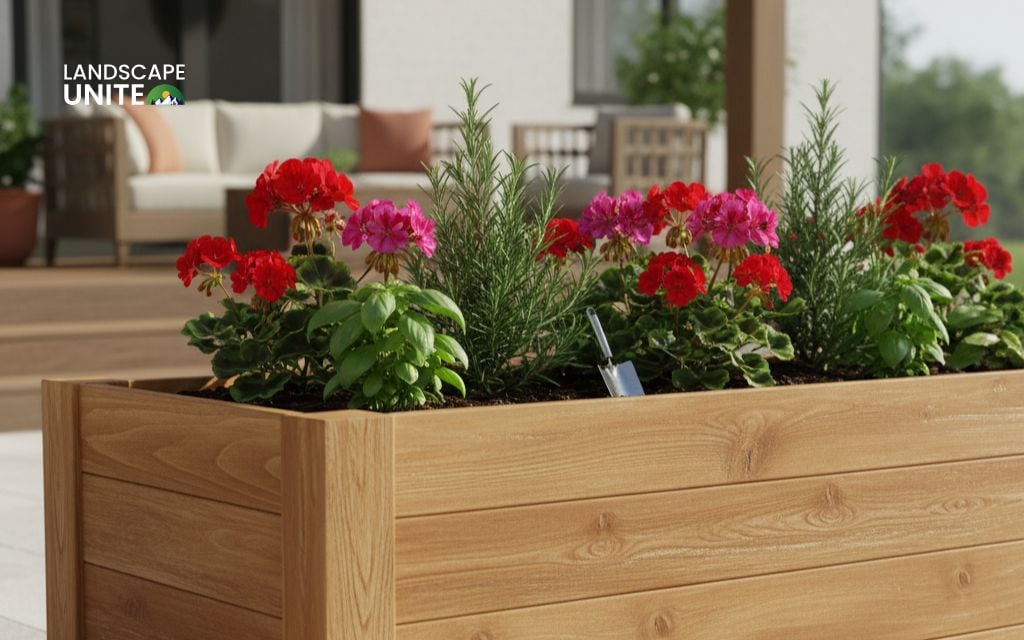
13. Driveway edge flower bed
Soften the hard edges of driveways and walkways with narrow borders that add color without interfering with traffic flow.
- Lavender provides fragrance, purple flowers, and silvery foliage that looks good year-round.
- Dwarf daylilies offer grass-like foliage and trumpet flowers in various colors.
- Creeping phlox creates a carpet of spring blooms that suppresses weeds.
Keep plants low to maintain sight lines for vehicle safety.
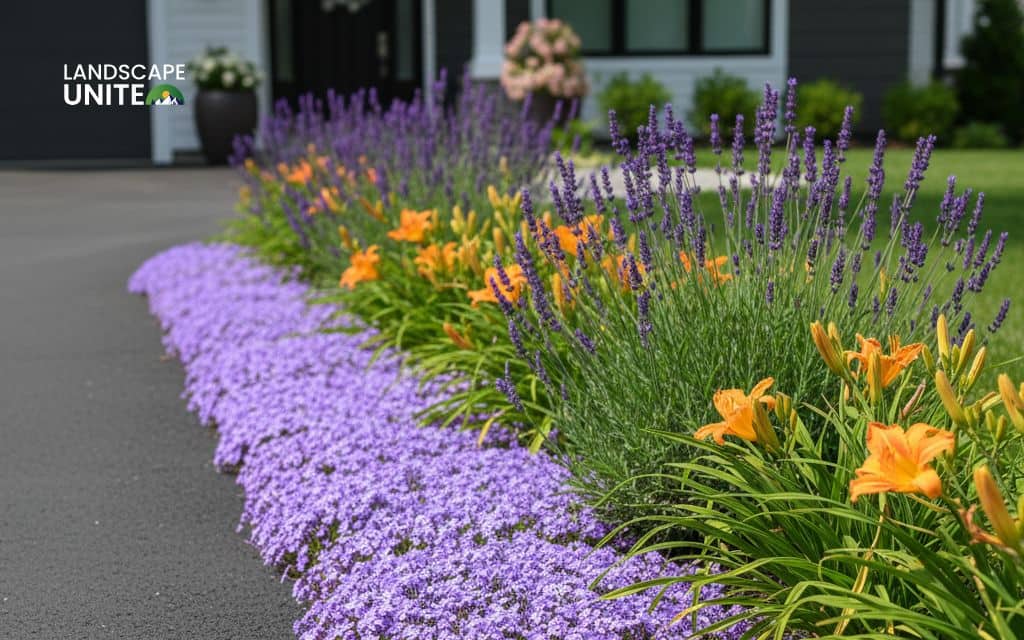
14. Butterfly and bee mini garden
Support declining pollinator populations with plants chosen for their nectar and pollen.
- Milkweed serves as the only host plant for monarch butterflies while providing fragrant flower clusters.
- Lantana blooms continuously in hot weather, offering nectar when other flowers fade.
- Salvia produces tubular flowers perfect for long-tongued pollinators.
- Add shallow water sources like plant saucers with landing stones for drinking and cooling.
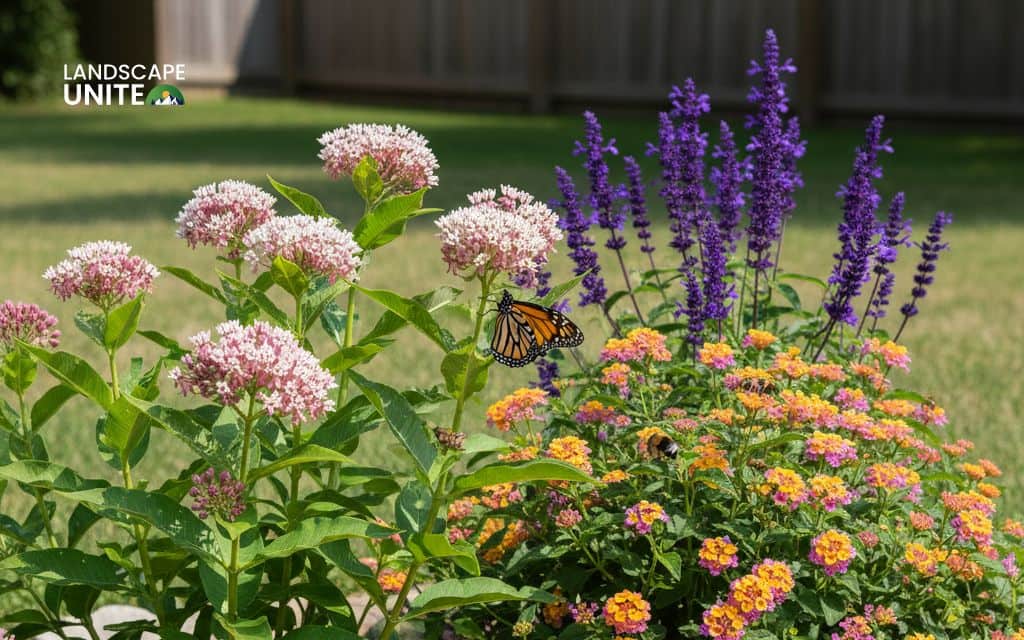
15. Foundation bed for curb appeal
Frame your home’s foundation with plantings that enhance architectural features while providing multi-season interest.
- Hydrangeas offer large, showy flowers in summer and interesting dried blooms in winter.
- Coral bells provide colorful foliage from spring through fall, with delicate flower spikes adding vertical accent.
- Plant spring bulbs like tulips and daffodils for early season color that emerges before perennials fully develop.
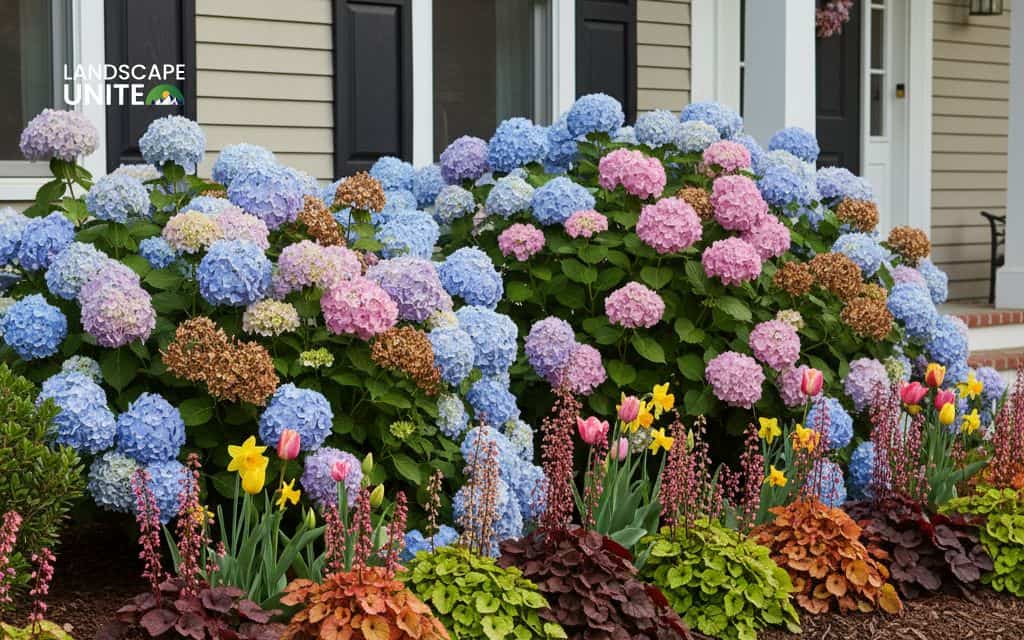
16. Tiny triangle bed by mailbox
A triangular bed beside your mailbox creates a welcoming accent that neighbors notice daily. Plant red begonias for a bold color that shows well from a distance. Creeping Jenny provides bright chartreuse foliage that contrasts beautifully with red flowers. Edge with white alyssum for delicate texture and sweet fragrance that greets visitors collecting mail.
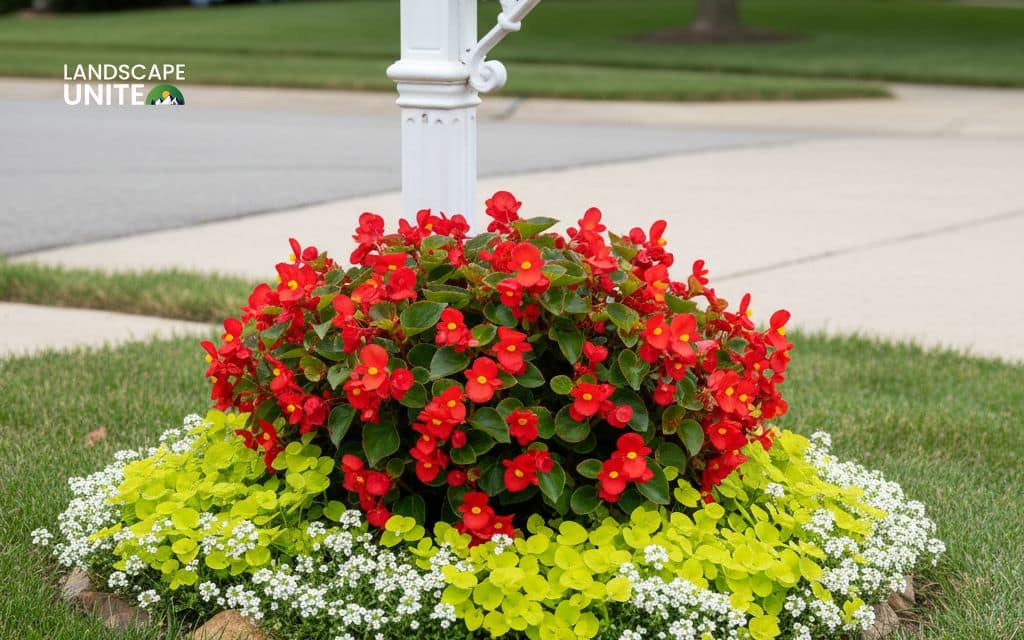
17. Rustic cottage-style bed
Embrace informal, overflowing abundance with plants that self-seed and naturalize. Allow Shasta daisies to form loose clumps alongside lavender’s aromatic mounds. Add tall foxgloves for vertical accent and cottage garden authenticity.
Let plants grow into natural shapes rather than forcing rigid patterns. This relaxed approach creates charming, lived-in appeal that improves with age as plants settle into comfortable arrangements.
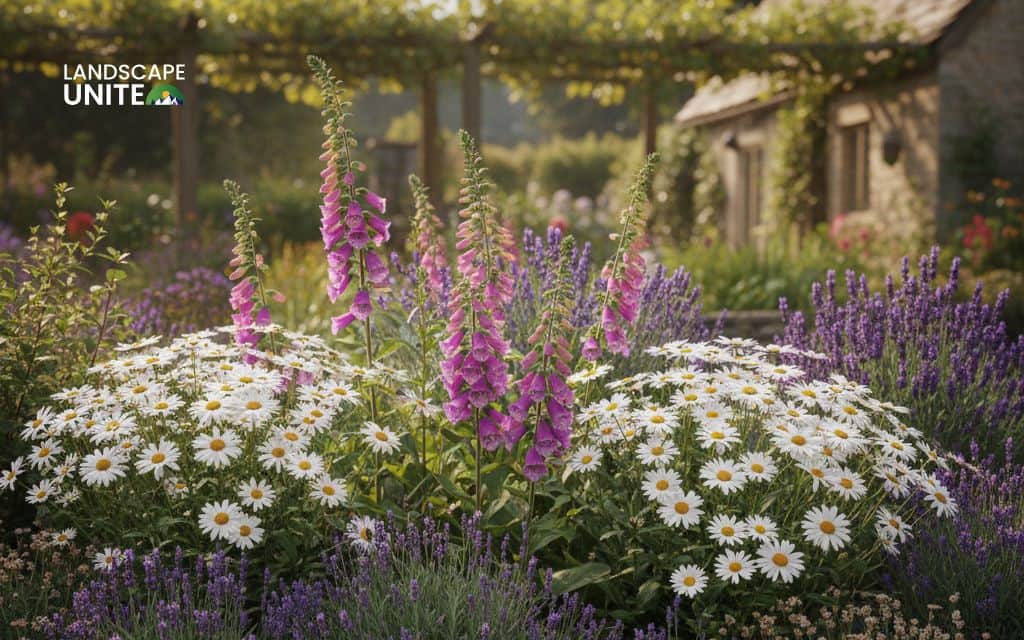
18. Brick border flower bed
Create classic definition with traditional brick edging that complements virtually any architectural style. The warm red tones of brick harmonize beautifully with orange and red marigolds.
Add pink and red geraniums for complementary colors that create rich, warm combinations. Brick edging prevents grass encroachment while creating clean lines that make maintenance easier.
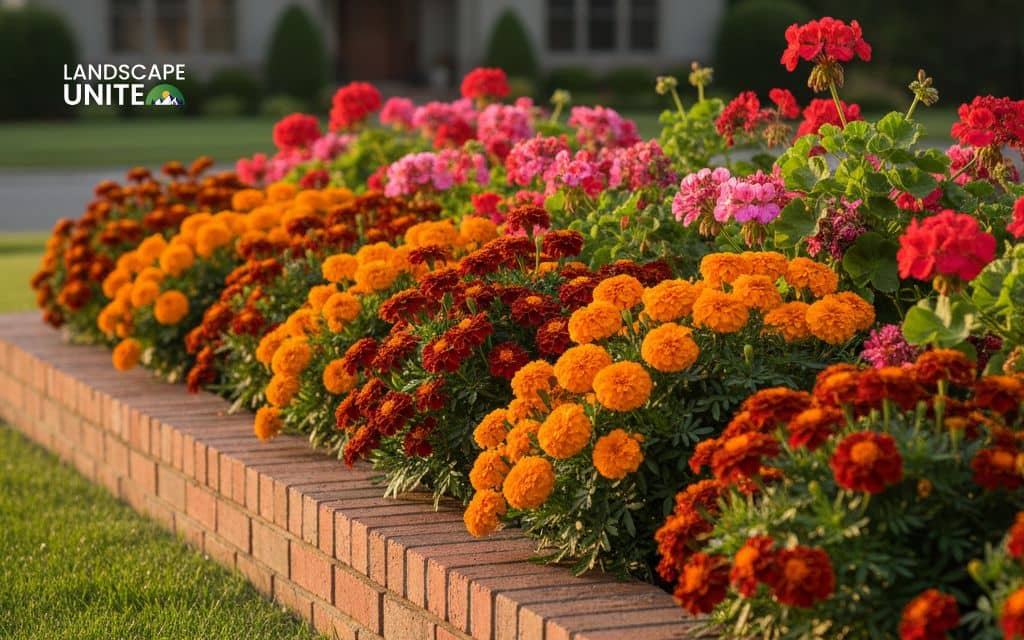
19. Small backyard corner bed
Use curved lines to soften fence angles and create more natural, flowing shapes than rigid rectangles. Combine evergreen shrubs for year-round structure with ornamental grasses for movement and seasonal change. Add perennial flowers for color and fragrance that make corners inviting rather than forgotten.
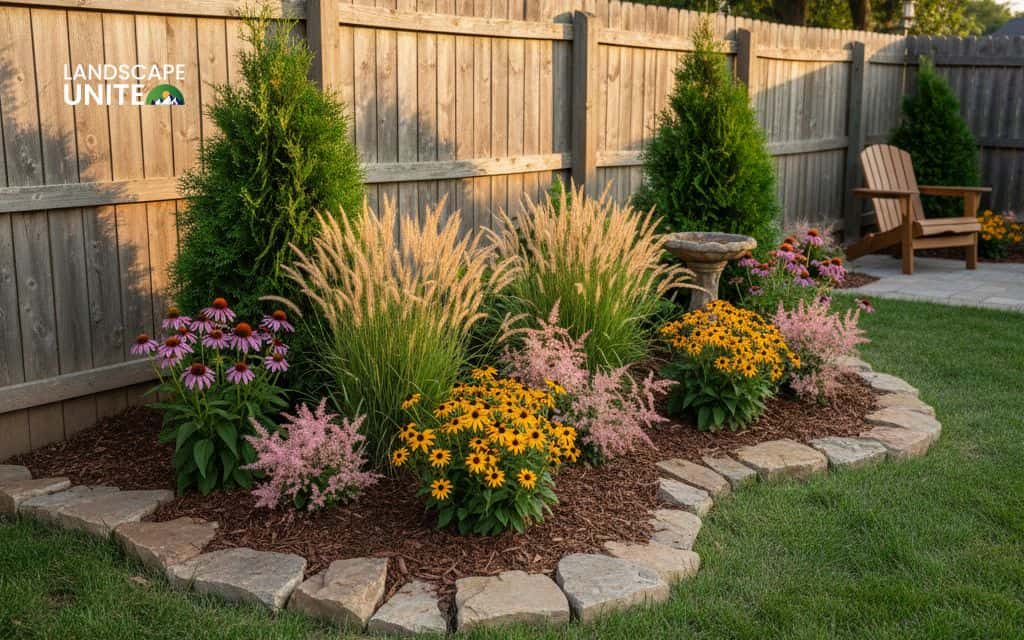
20. Color-themed mini garden
Create sophisticated, intentional designs by limiting your palette to variations of a single color family.
- Pink themes might include pale pink cosmos, medium pink zinnias, and deep rose-colored petunias.
- Monochromatic schemes feel elegant and professional while simplifying plant selection.
Add plants with silver or chartreuse foliage to prevent monotony and provide neutral transition between colors.
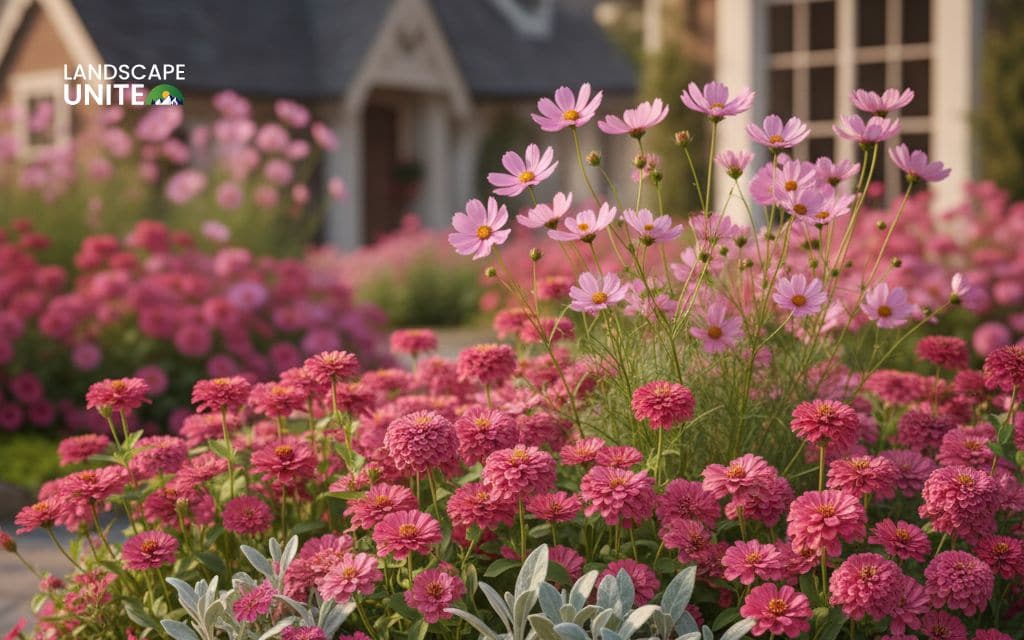
21. Pebble path flower border
Edge walkways with low-growing plants that soften hard surfaces while withstanding occasional foot traffic. Creeping thyme releases fragrance when brushed against and produces tiny flowers that attract beneficial insects.
Small dianthus varieties offer grass-like foliage and sweetly scented flowers in pink, white, or red. Use contrasting colored stones or gravel to define the border and add textural interest.
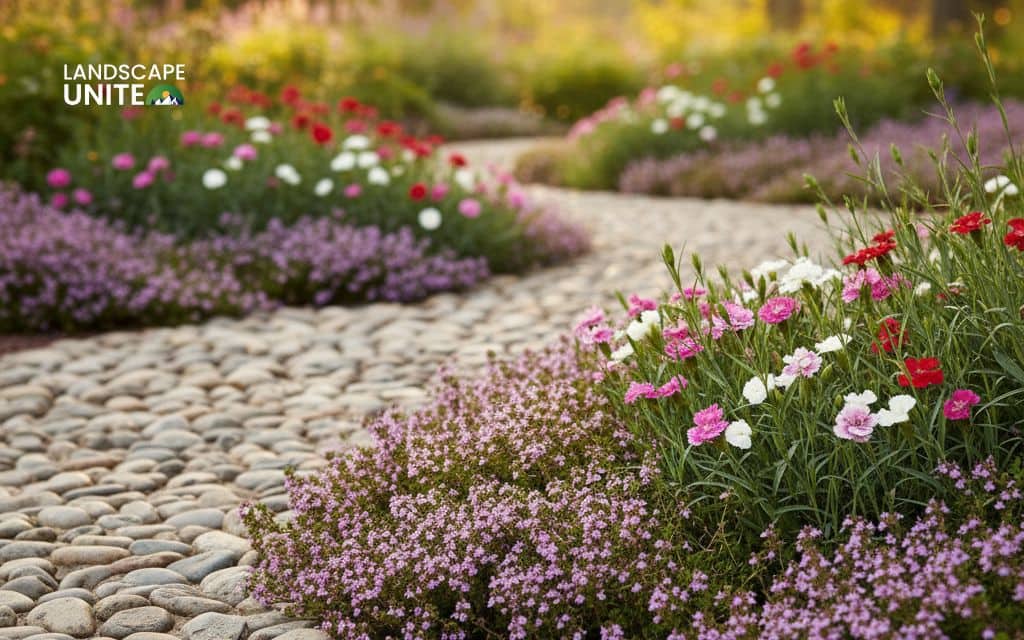
22. Hanging basket flower bed hybrid
Maximize color in minimal space by combining ground-level plantings with hanging baskets above. This layered approach creates vertical gardens perfect for patios and small yards. Choose trailing plants for baskets that cascade down toward ground plants, creating unified color columns.
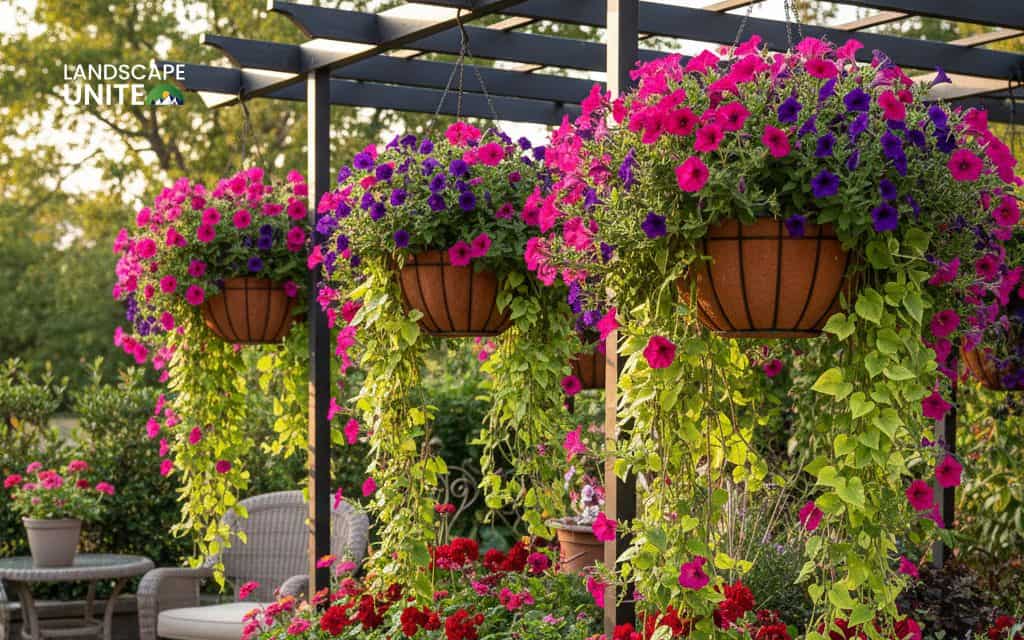
23. Tropical mini oasis
Create exotic appeal with bold foliage plants that provide drama even without flowers.
- Canna lilies offer large paddle-shaped leaves and bright flower spikes in orange, red, or yellow.
- Coleus provides leaf color variety in patterns and combinations impossible to achieve with flowers alone.
- Caladiums add heart-shaped leaves in stunning pink and white patterns that glow in shade.
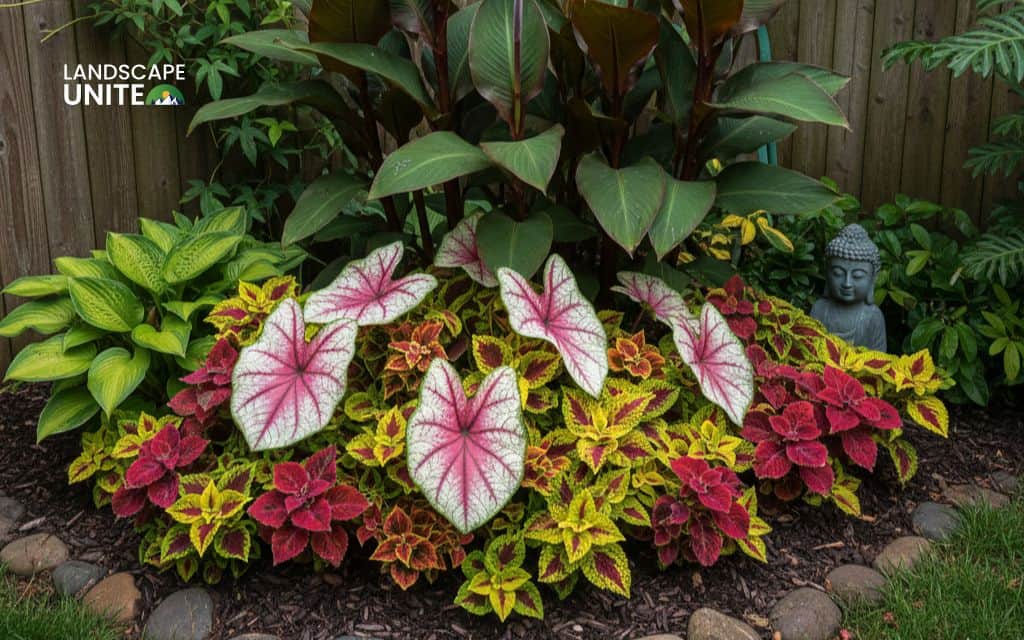
24. Low-maintenance perennial patch
Busy homeowners need gardens that don’t demand constant attention. Coreopsis blooms all summer with minimal care, producing cheerful yellow flowers that attract butterflies.
Catmint forms neat mounds of aromatic foliage topped with purple-blue flower spikes. Sedums provide interesting foliage all season and late-summer flowers that transition to attractive seed heads for winter interest.
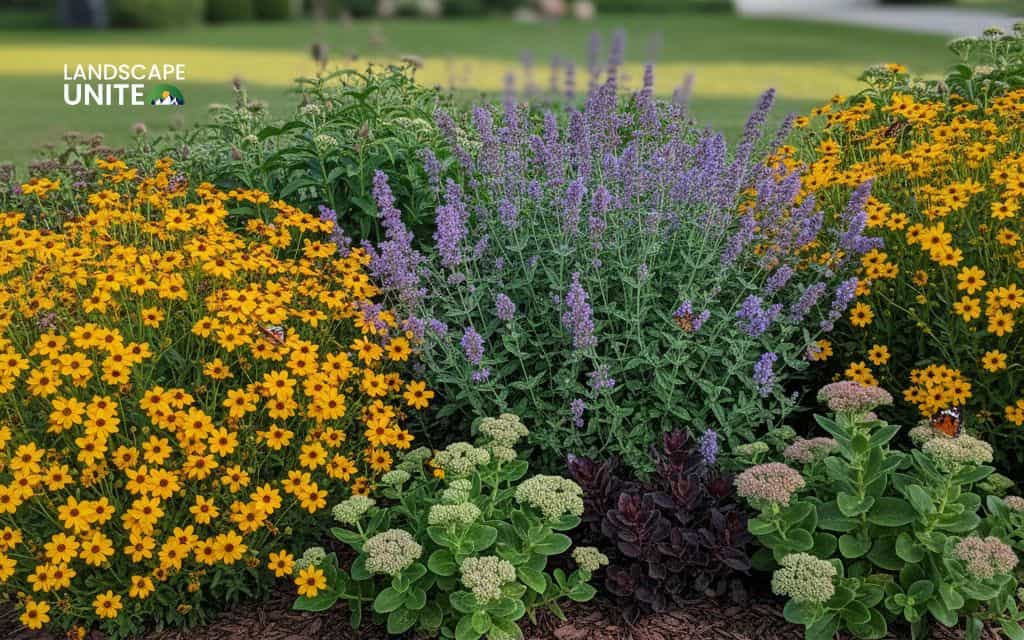
25. Small flower bed around a tree
Utilize the filtered shade beneath mature trees for specialized garden areas.
- Tree roots create challenging growing conditions, so choose shallow-rooted plants that tolerate competition.
- Hostas adapt to various light levels and provide architectural foliage in multiple sizes and colors.
- Ferns add fine texture and naturalistic appeal, while impatiens provide continuous color throughout the growing season.
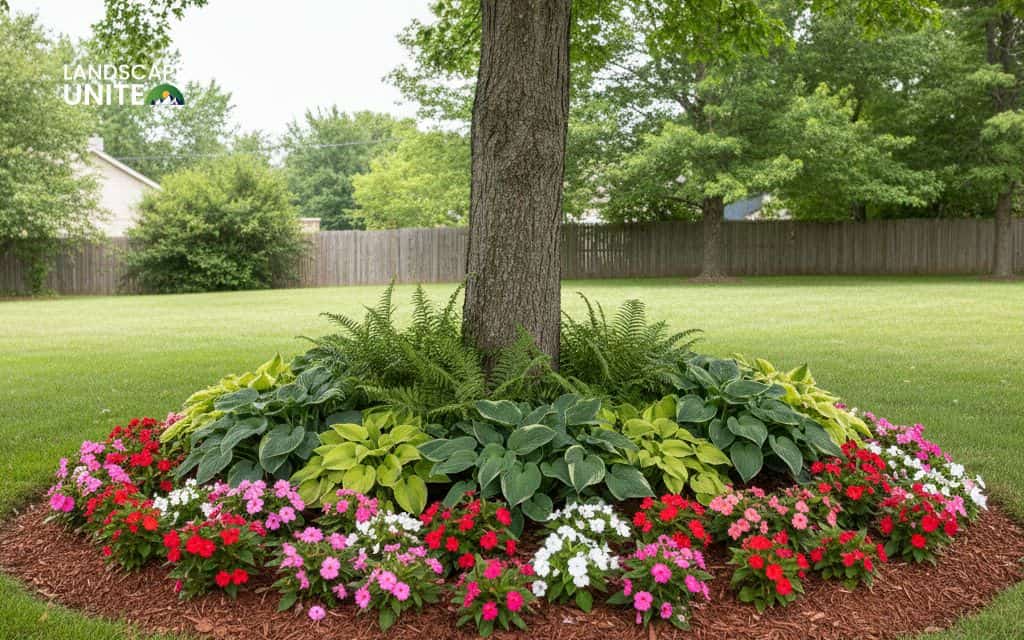
26. Small entryway bed with mixed heights
Create welcoming entrances with carefully planned height progressions that guide the eye upward toward your door. Tall snapdragons provide a vertical accent in the background. Mid-height geraniums offer reliable color and classic appeal, while low lobelia creates a carpet of small flowers along the front edge. This arrangement feels balanced and intentional while maximizing visual impact.
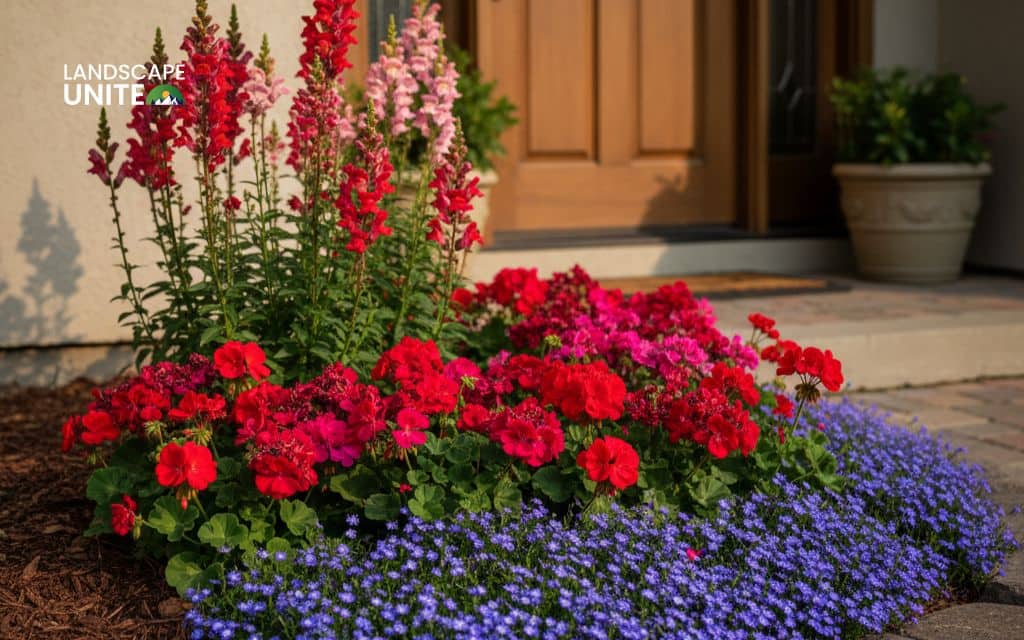
27. Vertical wall flower bed
Maximize growing space in minimal square footage with wall-mounted planters or shelving systems. Use lightweight containers filled with succulents and small trailing flowers. Ensure proper drainage and easy access for maintenance. This approach works for patios, balconies, or anywhere ground space is limited.
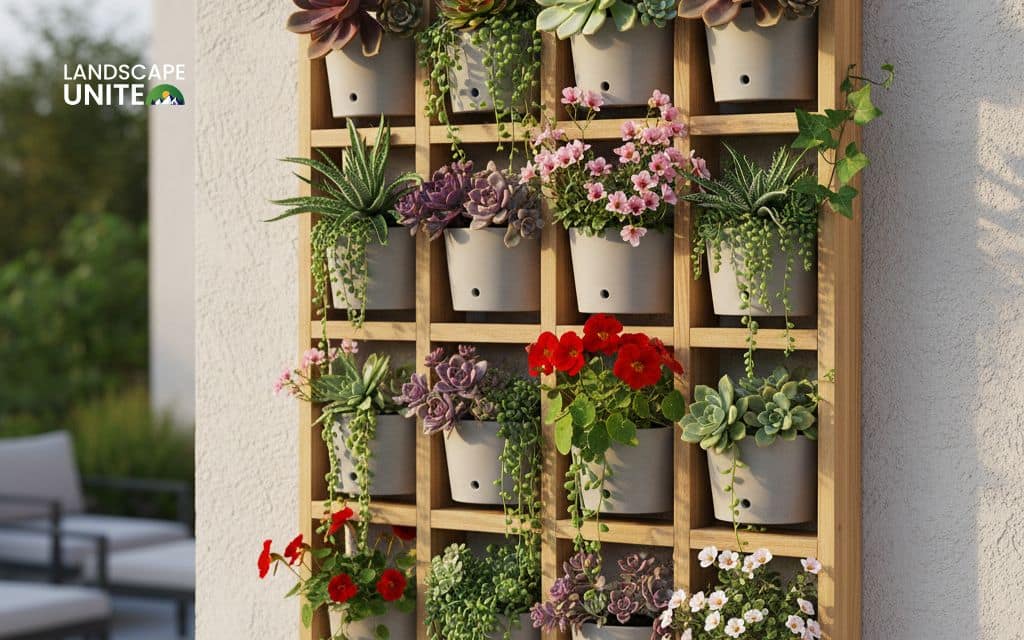
28. Shady patio corner bed
Soften hardscape areas with plants that thrive in the dappled light common around patios and decks. Ferns provide fine texture and cooling green presence that makes outdoor spaces feel more natural.
Begonias offer continuous blooms in shade conditions, while coleus contributes incredible foliage color that rivals any flower display. These combinations create peaceful retreats that enhance outdoor living spaces.
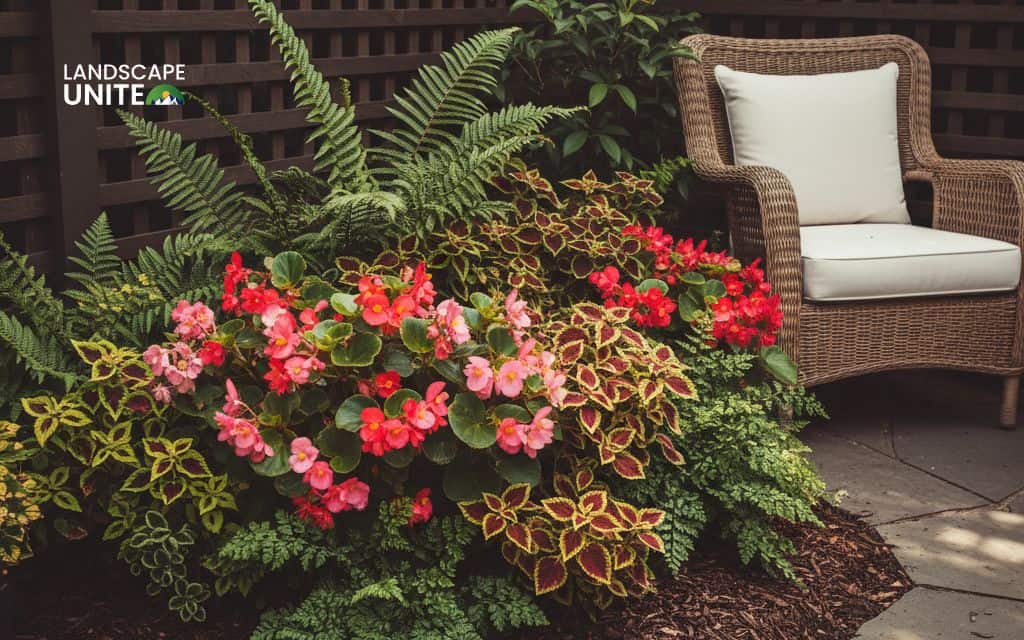
Conclusion
Small flower beds prove that size doesn’t determine impact. These 28 ideas demonstrate how thoughtful design, appropriate plant selection, and creative use of space can transform any area into a garden showpiece.
The key to success lies in matching your design to your specific conditions, maintenance preferences, and personal style. Start with one small bed to build confidence and experience, then expand your garden as your skills and enthusiasm grow.
Pick your favorite design today and start planning – your small garden can make a statement as big as your imagination!
Need more ideas to decor your flower bed and garden? Check out our comprehensive gardening library on our website today!
Frequently asked questions (FAQs)
What flowers are best for small flower beds?
Choose compact, long-blooming varieties that provide maximum color impact. Petunias, salvias, and dwarf zinnias bloom continuously from spring until frost. Add structure with compact perennials like coreopsis, catmint, and dianthus that return each year with minimal care.
How do I make a small flower bed look bigger?
Use layered planting heights, curved edges instead of straight lines, and lighter colors that advance visually. Mirror larger garden design principles in miniature – create focal points, repeat elements for unity, and use fine-textured plants to add depth and complexity.
How often should I water small flower beds?
Most established flower beds need deep watering 2-3 times per week rather than daily shallow watering. Check soil moisture by inserting your finger 2 inches deep – water when dry at this level. Newly planted beds require more frequent watering until roots establish.
Can I mix perennials and annuals in the same bed?
Absolutely! This combination provides the best of both worlds – perennials offer reliable structure and return each year, while annuals provide flexible seasonal color that can change with your preferences or special occasions.
What’s the easiest low-maintenance small flower bed idea?
A raised bed filled with hardy perennials and covered with organic mulch requires minimal ongoing care. Choose drought-tolerant plants like sedums, coreopsis, and native grasses that thrive with minimal intervention once established. Good soil preparation and mulch reduce weeding and watering significantly.
